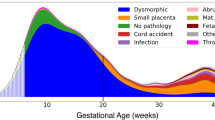Abstract
Objective:
To determine if the second trimester placental location is associated with perinatal outcomes.
Materials and methods:
Observational study of placental location and the subsequent risk of an adverse pregnancy outcome. Placental location was divided into three categories, low, high lateral and high fundal.
Results:
There were 3336 pregnancies analyzed in this study. Low implantation sites had a greater risk of preterm labor (odds ratio (OR) 1.70, 95% confidence interval (CI) 1.38 to 2.90, P<0.001), preterm delivery (OR 1.86, 95% CI 1.36 to 2.54, P<0.001), fewer fetuses with macrosomia (OR 0.56, 95% CI 0.38 to 0.83, P=0.010) and reduced risk of postpartum hemorrhage (OR 0.56, 95% CI 0.46 to 0.95, P=0.026). High lateral implantations had a greater risk of low 1-min (OR 1.80, 95% CI 1.11 to 2.93, P=0.017) and 5-min (OR 3.49, 95% CI 1.46 to 8.36, P=0.005) Apgar scores.
Conclusions:
Low placental implantation was associated with an increased risk of preterm labor, preterm delivery and a reduced risk of postpartum hemorrhage, and of a macrosomic fetus. High lateral implantation was associated with low Apgar scores.

Similar content being viewed by others
References
Bhide A, Prefumo F, Moore J, Hollis B, Thilanganathan B . Placental edge to internal os distance in the late third trimester and mode of delivery in placenta previa. BJOG 2003; 110: 860–864.
Leiberman JR, Fraser D, Kasis A, Mazor M . Reduced frequency of hypertensive disorders in placenta previa. Obstet Gynecol 1991; 77: 836–839.
Bobrowski RA, Jones TB . A thrombogenic uterine pack for postpartum hemorrhage. Obstet Gynecol 1995; 85: 836–837.
Gonser M, Tillack N, Pfeiffer KH, Mielke G . Placental location and incidence of preeclampsia. Ultraschall Med 1996; 17: 236–238.
Vaillant P, Best MC, Cynober E, Devulder G . Pathological uterine readings when the placenta is laterally situated. J Gynecol Obstet Biol Reprod 1993; 22: 301–307.
Fianu S, Vaclavinkova V . The site of placental implantation as a factor in the aetiology of breech presentation. Acta Obstetr Gynecol Scand 1978; 57: 371–372.
Newton ER, Barass V, Cetrulo CL . The epidemiology and clinical history of asymptomatic midtrimester placenta previa. Am J Obstet Gynecol 1984; 148: 743–748.
Newnham JP, Evans SF, Michael CA, Stanley FJ, Landau LI . Effects of frequent ultrasound during pregnancy: a randomised controlled trial. Lancet 1993; 342 (8876): 887–891.
Magann EF, Evans SE, Newnham JP . Placental implantation at 18 weeks and migration throughout pregnancy. South Med J 1998; 91: 1025–1027.
Author information
Authors and Affiliations
Corresponding author
Rights and permissions
About this article
Cite this article
Magann, E., Doherty, D., Turner, K. et al. Second trimester placental location as a predictor of an adverse pregnancy outcome. J Perinatol 27, 9–14 (2007). https://doi.org/10.1038/sj.jp.7211621
Received:
Revised:
Accepted:
Published:
Issue Date:
DOI: https://doi.org/10.1038/sj.jp.7211621
- Springer Nature America, Inc.
Keywords
This article is cited by
-
Cumulative Prenatal Risk Factors and Developmental Coordination Disorder in Young Children
Maternal and Child Health Journal (2023)
-
Relationship between placenta location and resolution of second trimester placenta previa
Journal of Huazhong University of Science and Technology [Medical Sciences] (2017)




